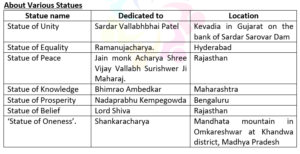Published on: September 25, 2023
Shankaracharya
Shankaracharya
Why in news? The 108-foot-tall statue of Adi Shankaracharya was unveiled on the Mandhata mountain in Omkareshwar at Khandwa district, Madhya Pradesh.
Highlights:
- The statue is called as ‘Ekatmata Ki Pratima’ or the ‘Statue of Oneness’.
- Statue depicts Shankaracharya as a 12-year-old child when he is said to have visited Omkareshwar.
Who was Adi Shankaracharya?
- Adi Shankara, is believed to have lived between 788 and 820 AD, was born in Kerela’s Kaladi, situated on the bank of the Periyar River.
- He became a sanyasin at an early age and left his household, where he is said to have made his way to Omkareshwar.
- At Omkareshwar, he studied under his guru Govinda Bhagavatpada and soon became a proponent of Advaita Vedanta, challenging prevailing philosophical traditions – including Buddhism and Jainism.
- He established four major mathas at Badrinath, Dwarka, Puri and Sringeri.
Philosphy
- Shankaracharya advocated the Advaita or the doctrine of the oneness of the individual soul and the Supreme God which is the Ultimate Reality.
- He taught that Brahman, the only or Ultimate Reality, was formless and without any attributes.
- Considered the world around us to be an illusion or maya, and preached renunciation of the world and adoption of the path of knowledge to understand the true nature of Brahman and attain salvation.
Books and Commentaries
- Shankara is said to have authored 116 works and most notable among them are the commentaries on the 10 Upanishads, the Brahmasutra and the Gita.
- He composed meditative hymns like Soundarya Lahari, Sivananda Lahari, Nirvana Shalkam and ‘Brahmasutrabhasya’(commentary on Brahma Sutra).
- AtmaBodha, UpadesaSahasri , VaakyaVritti, and VivekaChudamani are his major compositions
Why is the Mandhata island considered an important religious destination?
- The Mandhata island, is on the Narmada River and home to two of the 12 Jyotirlingas – Omkareshwara (located on the south side of the island) and Amareshwara.
- The area is close to Mahakaleshwara Jyotirlinga at Ujjain and island is dotted with Shaivite, Vaisnavite, and Jain temples dating back to the 14th and 18th centuries.
- The name ‘Omkareshwar’ is derived from the shape of the island, which resembles the sacred syllable ‘Om’.


